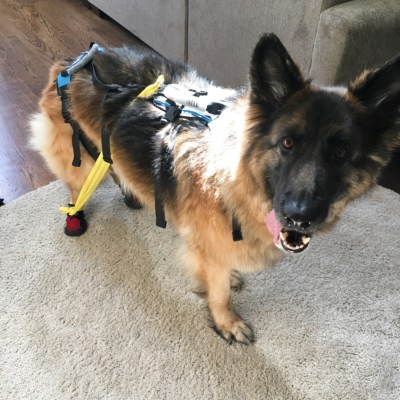As a German Shepherd owner, you may have heard about a devastating disease called Degenerative Myelopathy. Often thought of as the canine equivalent of Multiple Sclerosis, this progressive neurological condition affects the spinal cord and ravages muscle coordination, starting in the hind legs and eventually affecting the front legs, as well. Since many dogs have lost muscle tone prior to their diagnosis, it is important to gradually build up their level of activity, so gently and easily increase the affected dog’s exercise level. While it also appears in other large breeds, Degenerative Myelopathy (DM) is most prevalent in German Shepherds, and usually becomes apparent in dogs from 5-14 years old.
Watch for these symptoms
If your German Shepherd displays one or more of these symptoms, consult your veterinarian right away.
- - Progressive weakness of the hind limbs
- - Dragging nails
- - Difficulty rising
- - Difficulty jumping
- - Stumbling
- - Knuckling of the toes
- - Wearing of the inner toes of the rear paws
- - Loss of muscle in the trunk legs
- - Tremors of the rear legs
Treatment for Degenerative Myelopathy
Sadly, there is no significantly effective treatment for DM, and the disease tends to disable within months. While the prognosis for a dog with this disease is grave, the quality of life of an affected canine can be improved by good care. Exercies usually and physical rehabilitation can be helpful in maintaining the dog’s well-end up beinging, maximizing muscle tone and strength, and maintaining good circulation and conditioning. Over a few to several months, it progresses to the point where a dog can no longer walk.
The outlook
Hopefully, veterinary science will develop disease-modifying drugs similar to those used to treat Multiple Sclerosis to slow or halt the progression of the disease. In addition, the discovery of a gene that identifies dogs at risk for developing DM could pave the way for therapeutic trials of medications that will prevent the disease from establishing. This discovery might also alert breeders about which dogs carry the genes, so they can choose not to breed them.

